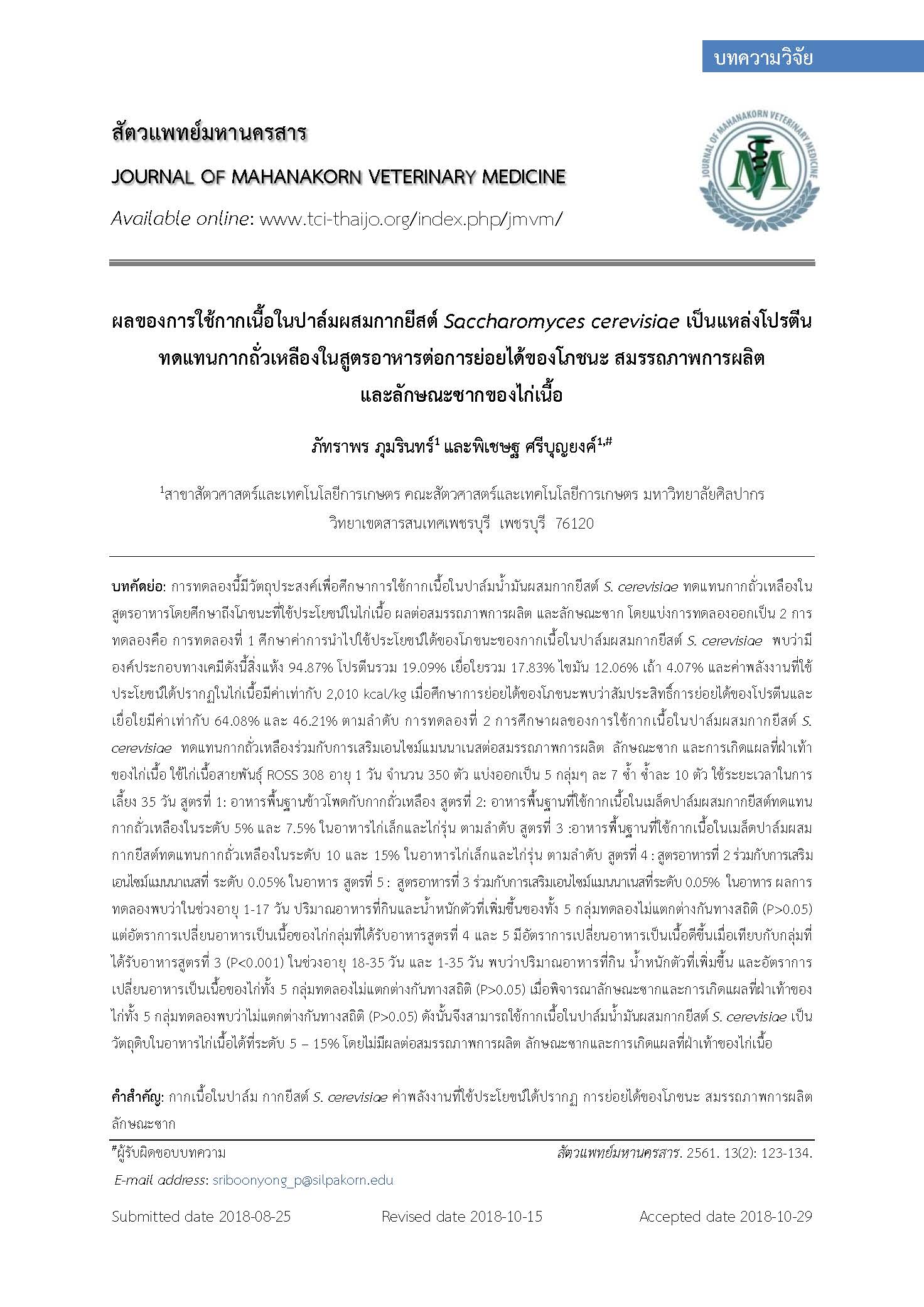Effect of Using Palm Kernel Meal and Saccharomyces cerevisiae as Protein Source for Soybean Meal Replacement in Diet on Nutrients Digestibility, Productive Performance and Carcass Traits in Broiler
Main Article Content
Abstract
TThe aim of the study was to investigate effects of palm kernel meal with S. cerevisiae as protein source on nutrient digestibility, productive performance and carcass traits in broilers. There were two experiments in this study. Experiment 1 was the study of effects of palm kernel meal and S. cerevisiae in diet on nutrients digestibility. The results revealed that chemical composition of palm meal with S. cerevisiae consisted of 94.87% of dry matter, 19.09% of crude protein, 17.83% of crude fiber, 12.06% of fat , 4.07% of ash and 2,010 kcal/kg of apparent metabolizable energy in broiler. It was found that coefficients of protein and fiber digestibility were 64.08% and 46.21% , respectively. Experiment 2 was the study of effects of using palm kernel meal with S. cerevisiae in diets on productive performance, carcass traits and foot pad lesion in broilers. A total of 350 birds of one-day-old Ross 308 were divided into five dietary treatments, 7 replications each, 10 chicks per replication. Dietary treatments consisted of Treatment 1: control diet, Treatment 2; control diet using palm kernel meal and S. cerevisiae replaced with soybean meal at 5, 7.5% Treatment 3; control diet using palm kernel meal and S. cerevisiae replaced with soybean meal at 10, 15% in starter diet and grower diet, respectively. Treatment 4; treatment 2 supplemented with mannanase enzyme at 0.05% of diet. Treatment 5; treatment 3 supplemented with mannanase enzyme at 0.05% of diet. The results revealed that at 1-17 day of age, average feed intake was not significantly different (P>0.05) but FCR of treatment 4 and 5 were better than treatment 3 (P<0.05). At 18-35 and 1-35 days of age, it was found that average feed intake, weight gain and FCR were not significantly different (P>0.05) among treatment groups. There was no significant difference (P>0.05) in carcass traits and foot pad lesion among treatment groups. In conclusion, palm kernel meal can be used with S. cerevisiae as feed stuff in broiler diet at 5 – 15% without negative effects on productive performance, carcass traits and foot pad lesion in broiler.
Article Details
References
Vorachantra, S. and R. Sittikripong. 2539. Animal Nutrition. Odeon Store. Bangkok.
Chandorn, S. and C. Piyapittayanun. 2555. Production and Application of Microbial Mannanases. Journal of Science and Technology 20(4): 365-377.
A’dilah, M.M. and A. R. Alimon. 2011. Improving the nutritive value of palm kernel cake (PKC) through chemical pre-treatment and fungal fermentation. p.39. Paper presented at the 32nd Annual Conference Malaysian Society of Animal Production (MSAP) 6th-9th June 2011 at Tawau, Sabah, Malaysia.
A.O.A.C..1990. Official Methods of Analysis. 15th ed. Association of Official Analytical Chemists, Inc., Virginia.
Bello, K. M., E. O. Oyawoye, S. E. Bogoro, U. D. Dass. 2011. Performance of broilers fed varying levels of palm kernel cake. Int. J. Poult. Sci. 10(4): 290-294.
Berg, C. 1998. Foot pad dermatitis in broilers and turkeys. Doctoral diss. Dept. of Animal Environment and Health, SLU. Acta Universitatis Agriculturae Sueciae, Sweden.
Chenost, M., & Kayouli, C. 1997. Roughage utilization in warm climates. FAO animal production and health paper, (135).
Garcia, C.A., A.G. Gernat and J.G. Murillo. 1999. The effect of four levels of palm kernel meal in broiler diets. CEIBA, 40: 29-295.
Kperegbeyi J. I. and S. E. Ikperite. 2011. The effectiveness of replacing maize with palm kernel cake in broiler’ starter diet. Journal of Environmental Issues and Agriculture in Developing Countries. 3(1): 145-149.
Lawal, T.E., E. A. Iyayi, B. A. Adeniyi and O. A. Adaromoye. 2010. Biodegradation of Palm Kernel Cake with Multienzymes Complexes from Fungi and its Feeding Value for Broilers. Int. J. Poult Sci. 9(7): 695-701.
Mohamed, I. A, C. L. Teck, L. F. Hooi. H. L. Wei and Q. S. Awis. 2014. (Cited 1 August 2018) Biodegradation of Palm Kernel Cake by Cellulolytic and Hemicellulolytic Bacterial Cultures through Solid State Fermentation. Scientific World Journal. Available from: https://www.ncbi.nlm.nih.gov/pmc/articles/PMC4082864/
Ng, K. L. and A. M. Khan. 2012. Enzymatic preparation of palm kernel expeller protein hydrolysate (PKEPH). International Food Research Journal 19(2): 721-725
Ng, W.K. 2004. Researching the use of palm kernel cake in aquaculture feeds. Palm Oil Developments. 41: 19-21.
Nuzul, A. B. 2013. Characteristics of malaysian palm kernel and its products. J. Oil Palm Res. 25(2): 245-252.
Philippine Society of Animal Nutritionists. 2010. Philsan Feed Reference Standards 4th ed. University of Philippines Los Banos. College, Laguna. 498 p.
R Core Team (2016). R: A language and environment for statistical computing. R. Foundation for Statistical Computing, Vienna, Austria. URL https://www.R-project.org/.
Sharmila, A., A. R. Alimon,, K. Azhar, H. M. Noor and A. A. Samsudin. 2014. Improving Nutritional Values of Palm Kernel Cake (PKC) as Poultry Feeds: A Review. Mal. J. Anim. Sci. 17(1):1-18.
Wan Zahari, M. and A. R. Alimon. 2004. Use of palm kernel cake and oil palm byproducts in feed compounds. Palm Oil Developments. 40: 5-9.


